BMW 3 Series
The BMW 3 Series is a compact executive car manufactured by the German automaker BMW since May 1975. It is the successor to the 02 Series and has been produced in seven different generations.
| BMW 3 Series | |
|---|---|
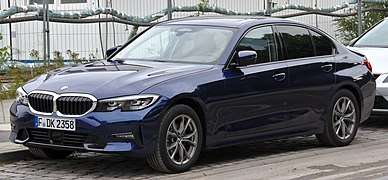 | |
| Overview | |
| Manufacturer | BMW |
| Production | 1975–present |
| Body and chassis | |
| Class | Compact executive car (D) |
| Chronology | |
| Predecessor | BMW 02 Series |
The first generation of the 3 Series was only available as a 2-door sedan (saloon), however the model range has since expanded to include a 4-door sedan, 2-door convertible, 2-door coupé, 5-door station wagon, 5-door liftback ("Gran Turismo") and 3-door hatchback body styles. Since 2013, the coupé and convertible models have been marketed as the 4 Series, therefore the 3 Series range no longer includes these body styles.
The 3 Series is BMW's best-selling model, accounting for around 30% of the BMW brand's annual total sales (excluding motorbikes).[1] The BMW 3 Series has won numerous awards throughout its history.
The M version of the 3 series, M3, debuted with the E30 M3 in 1986.[2]
First generation (E21; 1975–1983)
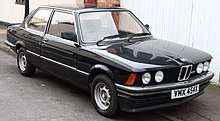
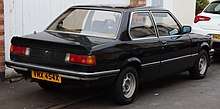
The E21 replaced the 02 Series and was initially available as a 2-door sedan (also described as coupé)[3]
At launch, all models used carburetted 4-cylinder engines; however, fuel-injected models were introduced in late 1975 and 6-cylinder engines were added in 1977. A cabriolet body style – manufactured by Baur – was available from 1978 to 1981.
Second generation (E30; 1982–1994)
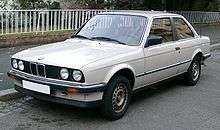
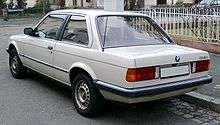
On introduction in 1982, the E30 was produced solely in the 2-door sedan body style. Four-door sedan models were introduced in 1983, convertibles were introduced in 1985 and estate ("Touring") models were introduced in 1987.
The E30 was the first 3 Series to be available in wagon and 4-door sedan body styles. It was also the first 3 Series to offer a diesel engine, and all-wheel drive was introduced to the 3 Series range with the 325iX model. The BMW Z1 roadster was based on the E30 platform.
The first BMW M3 was built on the E30 platform. The E30 M3 is powered by the high-revving S14 four-cylinder petrol engine, which produced 175 kW (235 hp) in its final European-only iteration.[4]
Third generation (E36; 1990–2000)
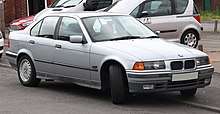

The E36 was sold in the following body styles: sedan, coupé, convertible, wagon (marketed as "Touring") and hatchback (marketed as "3 Series Compact").
The E36 was the first 3 Series to be offered in a hatchback body style. It was also the first 3 Series to be available with a 6-speed manual transmission (in the 1996 M3), a 5-speed automatic transmission and a four-cylinder diesel engine. The multi-link rear suspension was also a significant upgrade compared with previous generations of the 3 Series.
The E36 was named in Car and Driver magazine's 10Best list for every year it was on sale.[5]
The M3 model is powered by the S50 and S52 straight-six engines. It was sold in coupe, sedan and convertible body styles.
The BMW Z3 roadster and coupe models were based on the E36 platform.
Fourth generation (E46; 1997–2006)
_sedan_(2011-07-17)_01.jpg)
_sedan_02.jpg)
The E46 was sold in the following body styles: sedan, coupé, convertible, wagon (marketed as "Touring") and hatchback (marketed as "3 Series Compact").
The E46 generation introduced various electronic features to the 3 Series, including satellite navigation, electronic brake-force distribution, rain-sensing wipers and LED tail-lights.[6][7][8] All-wheel drive, last available in the E30 3 Series, was reintroduced for the E46. It was available for the 325xi and 330xi sedan/wagon models.[9][10] The E46 was the first 3 Series to be available with an engine using variable valve lift ("valvetronic").
The M3 version of the E46 was powered by the S54 straight-six engine and was available in coupé and convertible body styles (other than that, it was powered with the M54 in non-M3 cars). The transmissions available were a 6-speed manual or the 6-speed "SMG-II" sequential manual gearbox.[4]
Fifth generation (E90/E91/E92/E93; 2004–2013)
_sedan_(2011-07-17)_01.jpg)
_sedan_03.jpg)
The fifth generation 3 Series was produced in the sedan, wagon, coupé and cabriolet body styles. Due to the separate model codes for each body style, the term "E9X" is sometimes used to describe this generation of the 3 Series.
In 2006, the 335i became the first 3 Series model to be sold with a turbocharged petrol engine. The E90 also saw the introduction of run-flat tires to the 3 Series range. Consequently, cars with run-flats are not equipped with a spare tire.
The E90/E92/E93 M3 was powered by the BMW S65 v8 engine. It was released in 2007 and was produced in sedan, coupe and cabriolet body styles.
Sixth generation (F30/F31/F34; 2011–2019)
_M_Sport_sedan_(2018-11-02)_01.jpg)
_M_Sport_sedan_(2018-11-02)_02.jpg)
The F30/F31/F35 has been produced in the sedan, coupé, convertible, station wagon and 5-door hatchback ("Gran Turismo") body styles. A long wheelbase sedan is also available in China.
For the F30/F31/F34 series, the coupe and convertible models were produced until the 2013 year until 2014 when they were split from the 3 Series, redesigned, and sold as the BMW 4 Series. A new body style was introduced into the 3 Series range: the 3 Series Gran Turismo, a long-wheelbase hatchback.[11][12][13]
The F30/F31/F34 was the first time that the entire 3 Series range used turbocharged engines. In 2016, a plug-in hybrid drivetrain was first used in the 3 Series, in the 330e model.[14] Also in 2016, a 3-cylinder engine was used for the first time in a 3 Series.
The M3 version (designated F80, the first time an M3 has used a separate model designation) was released in 2014 and is powered by the S55 twin-turbo straight-6 engine.
Production ended in 2019 with the end of F31 Touring production in June.[15][16]
Seventh generation (G20; 2018–present)


The BMW 3 Series (G20) was unveiled at the 2018 Paris Motor Show on October 2, 2018. The official images of the vehicle were revealed a day prior to its unveiling. The seventh generation of the 3 Series is also offered as a station wagon.[17]
M version
_sedan_(2018-08-31)_01.jpg)
_sedan_(2018-08-31)_02.jpg)
The M3 is the most powerful version of the 3 Series, developed by BMW's in-house motorsport division, BMW M.
M3 models have been derived from the E30, E36, E46, E90/E92/E93, and F30 (designated F80) 3 series, and sold with coupe, sedan and convertible body styles. Upgrades over the "standard" 3 Series automobiles include more powerful and responsive engines, improved handling/suspension/braking systems, aerodynamic body enhancements, lightweight components, and interior/exterior accents with the tri-colour "M" (Motorsport) emblem.
The last M3 coupe was produced in Germany on 5 July 2013, replaced by the F82/F83 M4 Coupe and convertible starting with the 2015 model year,[18][19] but the M3 name remains in use for the sedan version.
Awards and recognition
The 3 Series has been on Car and Driver magazine's annual 10Best list 22 times, from 1992 through 2014, making it the longest running entry in the list.[20] In their December 2009 issue, Grassroots Motorsports magazine named the BMW 3 Series as the second-most important performance car built during the previous 25 years.
Production and sales
| Year | Production | EU sales | US sales* |
|---|---|---|---|
| 1980 | 25,771 | ||
| 1981 | 28,927 | ||
| 1982 | 35,190 | ||
| 1983 | 33,602 | ||
| 1984 | 30,868 | ||
| 1985 | 53,927 | ||
| 1986 | 61,822 | ||
| 1987 | 58,897 | ||
| 1988 | 34,914 | ||
| 1989 | 21,738 | ||
| 1990 | 22,825 | ||
| 1991 | 29,002 | ||
| 1992 | 38,040 | ||
| 1993 | 45,594 | ||
| 1994 | 46,287 | ||
| 1995 | 50,146 | ||
| 1996 | 50,248 | ||
| 1997 | 337,800[21] | 216,866 | 52,472 |
| 1998 | 376,900[21] | 247,786 | 57,520 |
| 1999 | 454,000[21] | 304,983 | 77,138 |
| 2000 | 509,007[21] | 330,604 | 89,681 |
| 2001 | 533,952[21] | 343,991 | 103,227 |
| 2002 | 561,249[21] | 350,606 | 115,428 |
| 2003 | 528,358[21] | 320,029 | 111,944 |
| 2004 | 449,732[21] | 269,216 | 106,549 |
| 2005 | 434,342[21] | 244,886 | 106,950 |
| 2006 | 508,479[21] | 289,597 | 120,180 |
| 2007 | 555,219[22] | 295,063 | 142,490 |
| 2008 | 474,208[23] | 251,334 | 112,464 |
| 2009 | 397,103[24] | 198,610 | 90,960 |
| 2010 | 399,009[25] | 183,122 | 100,910 |
| 2011 | 384,464 | 161,614 | 94,371 |
| 2012 | 406,752 | 175,022 | 99,602 |
| 2013 | 500,332[26] | 200,604 | 119,521 |
| 2014 | 480,214[27] | 168,275 | 142,232 |
| 2015 | 444,338[28] | 143,023 | 140,609 |
| 2016 | 411,844[29] | 144,561 | 106,221 |
| 2017 | 409,005 | 129,053 | 99,083 |
| 2018 | 366,475[30] | 106,991 | 75,957 |
* Figures since 2013 includes the BMW 4 Series
References
- "2010 BMW Group Annual Report" (PDF). BMW AG. Archived from the original (PDF) on 27 June 2011. Retrieved 17 October 2011.
- "BMW 3 Series". Edmunds.com. 22 January 2009. Archived from the original on 31 August 2009. Retrieved 3 October 2010.
- "BMW E21 3 Series specs". www.ultimatespecs.com. Retrieved 22 January 2017.
- "BMW M3 E30 2.5i (238Hp) EVO II". www.automobilio.info.
- "1998 10Best Cars - 10Best Cars". Retrieved 6 January 2017.
- "2000 BMW E46 M3 Review". www.topspeed.com. Retrieved 10 February 2017.
- "BMW E46 3 Series Buyer's Guide". www.reveuro.com. Archived from the original on 2 April 2013. Retrieved 10 February 2017.
- "BMW 3 Series (E46) - 2002, 2003, 2004, 2005". www.autoevolution.com.
- "BMW E46 3 Series". www.ultimatespecs.com.
- "BMW E46 3 Series Touring". www.ultimatespecs.com.
- "3 series GT configurations".
- "2017 BMW 3-series Gran Turismo". www.caranddriver.com. Retrieved 9 May 2018.
- "2018 BMW 3 Series Gran Turismo Review". www.edmunds.com. Retrieved 9 May 2018.
- "2016 BMW 330e Plug-In Hybrid First Drive".
- "BMW spendet letzten produzierten 3er Touring". carzoom.de (in German). Retrieved 29 July 2019.
- "BMW 3 Series Touring Set To Debut At 2019 Geneva Motor Show". CarBuzz.com. Retrieved 29 July 2019.
- "New 3 Series Touring Revealed". Cars.co.za. 12 June 2019.
- "BMW M3 Celebrating 20 Years of a Sporting Legend". www.worldcarfans.com. 27 February 2008. Retrieved 27 February 2012.
- "BMW M3 – The Evolution of the Benchmark". clubsportiva.com. 27 February 2012. Archived from the original on 18 September 2011. Retrieved 8 April 2013.
- "2009 10Best Cars – 10Best Cars/Best/Worst Lists/High Performance/Hot Lists/Reviews/Car and Driver". Car And Driver. 23 March 2008. Archived from the original on 29 June 2009. Retrieved 12 June 2009.
- http://www.autointell.com/european_companies/BMW/business-figures/BMW-business-figures-1997-2006-WB.xls
- "Annual Report 2007" (PDF). BMW Group. Retrieved 12 October 2019.
- "Annual Report 2008" (PDF). BMW Group. Retrieved 12 October 2019.
- "Annual Report 2009" (PDF). BMW Group. Retrieved 12 October 2019.
- "Annual Report 2010" (PDF). BMW Group. Retrieved 12 October 2019.
- LLC, BMW of North America. "BMW Group U.S. Reports December and 2013 Sales". www.prnewswire.com. Retrieved 15 September 2016.
- "Annual Report 2014" (PDF). BMW Group. Retrieved 12 October 2019.
- "Annual Report 2015" (PDF). BMW Group. Retrieved 12 October 2019.
- "Annual Report 2016" (PDF). BMW Group. Retrieved 12 October 2019.
- "Annual Report 2018" (PDF). BMW Group. Retrieved 12 October 2019.